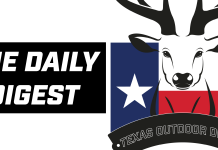The Daily Texas Outdoor Digest is sent to your inbox to keep you up to date about hunting, fishing, conservation and outdoors pursuits making headlines and going viral in the Lone Star State and beyond. It’s free, so subscribe today!
Here’s what’s worth reading today, Monday, November 11, 2019:
Wisconsin deer hunters targeted by animal rights extremists: When he was getting his deer stands ready for hunting season back in August, Scott McDermott from New Richmond, Wisc., one day found them tipped over and damaged. Someone cut the stilts in half. “This was 8 feet high. Now it’s 4 feet,” McDermott said. The windows were painted black. Inside, a message: “You are scum.” And on the roof, a threat: “The hunters will be hunted.” How did that make McDermott feel? “Pissed off,” he said.
Minnesota man drawn to hunting years after his father’s death afield: Brandon Van Tassell walked to his deer stand Saturday morning toting a .338 Savage and three decades’ worth of memories. Brandon, 34, was fairly new to the sport. He had begun hunting birds in his mid-20s. But not until two years ago did he consider giving deer hunting a try. Brandon wasn’t brought up as a hunter. But he was familiar with guns. Oftentimes he shot clays with his friends, and he knew his way around a rifle. “I didn’t keep Brandon away from hunting intentionally when he was young,” said his mom, Kimberly. “But I didn’t expose him to it, either. I knew he would be a safe hunter. Still, when he went, I just had to put it out of my mind. I couldn’t think about it.” Thirty years ago — Nov. 6, 1989 — Brandon was 4 years old when his dad, Kim, was killed on opening weekend of deer season. Another hunter shot him, mistaking him for a deer, even though Kim was riding his three-wheeler at the time.
Car-deer collisions peak with colder weather, time change, hunting: It’s November. Stay vigilant. As the temperature drops and the days grow short, vehicle-deer collisions increase. It’s a yearly cycle driven by biology, infrastructure, hunting and the time change. The primary driver of increased deer-vehicle collisions is the fact that deer are heading into mating season — known as the rut. This sends sex-focused male deer dashing across highways and roads. “The bucks are just not paying attention to anything,” said Sara Hansen, a deer specialist for the Washington Department of Fish and Wildlife. However, the secondary reasons for the increased collisions are human-related. First, the end of daylight saving time suddenly changes when humans are driving. “The animals don’t know that changing traffic pattern is coming,” Hansen said. “And then all of a sudden the humans have changed by an entire hour.”
Man bitten by 10-foot alligator while hog hunting: A man was airlifted to the hospital after a large alligator bit him on the leg near the DuPuis reserve while hog hunting. According to Martin County Fire Rescue, it took over an hour and a half to find the 46-year-old James Boyce, but he was eventually found in the heavy marsh area of the reserve. The man had a “substantial injury” to his leg and needed immediate assistance, the Martin County Sheriff’s Office says.
Researchers didn’t think humans attacked woolly mammoths — until they uncovered a trap in Mexico: At least 14 skeletons of woolly mammoths have been discovered in Mexico in pits apparently built by human hunters to trap and kill the huge animals some 15,000 years ago, according to Mexico’s National Institute of Anthropology and History. The discovery “represents a watershed, a touchstone on what we imagined until now was the interaction of hunter-gatherer bands with these enormous herbivores,” said Pedro Francisco Sánchez Nava, national coordinator of archaeology at INAH. The skeletons were found in Tultepec, about 25 miles north of Mexico City, in clay that had once been at the bottom of Lake Xaltocan. Archaeologists suggested that the clay area had opened up as the lake receded during the era of mammoths, providing hunters with a site easier to dig up to create traps.
Knoxville man killed in hunting accident, officials say: The Morgan County Sheriff’s Office responded to the Catoosa Wildlife Management area for a reported accidental shooting around 4:40 p.m. Friday. According to Sheriff Wayne Potter, officers identified the man as 38-year-old Jeffrey Dean, of Knoxville. Dean was killed from an apparent gunshot wound to the upper torso. Sheriff Potter said Dean was hunting with some family members and was mistaken for a deer in the heavily wooded area.
TPW Commission approves regulation changes for freshwater trotlines and other related gears: The Texas Parks & Wildlife Commission approved changes to the regulations on passive fishing gear (jug lines, minnow traps, perch traps, throwlines, and trotlines) to facilitate the removal of abandoned gear from public waters, make the presence of passive fishing gear identifiable to all users of public waters, and minimize the unintended take of aquatic resources. Before approving the proposed changes, commissioners, in response to public input, reduced the valid period for gear tags from 10 days to six days (instead of the proposed four) to shorten the time between angler inspections of their gear and reduce the negative impacts of abandoned passive fishing gear in Texas public waters. Scientific investigations conducted by the department show that fish mortalities as a result of “ghost fishing” (the continuing of effect of unattended passive gears) can increase after four days. Such devices can continue to fish and represent a danger to fish and other aquatic organisms when they are abandoned. Requiring the gear tag and the accompanying gear to be checked more frequently than 10 days should reduce those unintended mortalities.
TPWD inland fisheries staff considering freshwater fishing regulation changes for 2020-21: Texas Parks & Wildlife Department Inland Fisheries management staff are considering changes to freshwater fishing regulations at water bodies located in Cooke, Tom Green, Grayson and Williamson counties for 2020-21. In January, Inland Fisheries staff will present these possible changes to the Texas Parks & Wildlife Commission. If the Commission approves, the proposed changes will be published in the Texas Register, which begins the process of official public comment.
Mystery persists over who killed Minnesota deer hunter in 2016: Three years after Terry Brisk was shot to death while deer hunting in central Minnesota, his family remains desperate for answers and the sheriff remains committed to finding his killer. “It’s very hard,” said Terry’s mother, Babe Brisk. “This person is out and about and I have a son who’s dead.” She’s 73; her husband is 82. Before they die, they want to know who killed their 41-year-old son. “It’s heartbreaking. [Terry] has children who he should be doing things with and taking care of.” Babe talks to the sheriff every three weeks for an update on the investigation. “I know they’re working on it, but they just can’t say much,” she said. “[The sheriff] wants to keep the evidence to himself, because it’s information only the killer knows.”
Trophy whitetail makes hunter $50K richer: One common joke about deer hunters is that they’re willing to spend thousands of dollars a year to hunt for meat that costs a fraction of that. Andrew Lowe would beg to differ. Lowe, a schoolteacher from Ashford, in Boone County, found a way to make hunting pay. Last fall, he killed a Kanawha County buck that earned him a spot in the inaugural Bone Collector North American Whitetail Championship finals. A few weeks ago, he bagged a Kansas buck that earned the $50,000 first prize. It was a classic case of “spend money to make money.” The contest required participants to plunk down a $300 entry fee, and to record their hunts on Tactacam video equipment. A lot of hunters balked at the hefty entry fee, but Lowe decided to give it a whirl. “One spot in the finals was going to be available for hunters in the Virginia-West Virginia region,” he recalled. “I figured that since I was hunting in southern West Virginia, which has the biggest bucks in the region, it was worth taking a chance.”
Stay in the Know With The Daily Texas Outdoor Digest
If you haven’t subscribed yet, there’s no better time than right now (We hate spam and we won’t share your information with anyone. That’s just not cool):




















